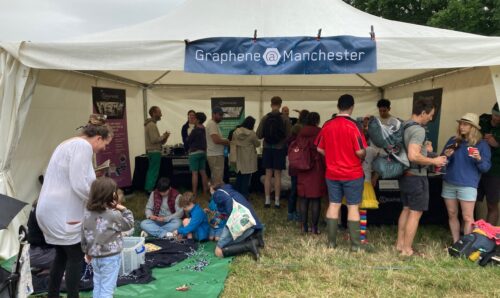Graphene membranes- creating the perfect barrier
Research 15 April 2016
Out next blogger is James Dix, who is currently studying for a PhD in the NOWNANO Centre for Doctoral Training (CDT). Originally from Bristol, he went on to study a Joint Honours Masters Degree in Chemistry and Physics in Durham, graduating in 2013. His speciality is in the area of graphene oxide membranes.
Could you give me an idea of the kind of work you do and how it relates to graphene specifically?
My work is heavily involved with graphene oxide membranes. I run computer simulations of graphene membranes to see how we can optimise them to make them potentially usable in desalination processes. The idea is that you can take a sheet of graphene, add loads of oxygen groups to it, and then create a layered structure that’s a graphene oxide membrane. And the separation between the sheets of graphene is about the same size as an ion, or a bit of salt in water. So we can then take seawater, pass it through this membrane and clean water will emerge.
What motivated you to have such an interest in graphene and this kind of research in general?
I originally did a summer project down in Bristol, with someone involved in their equivalent of the Graphene NOWNANO centre, and then when I was in 4th year at Durham, I did a lot of computer modelling at an atomistic level building up picture of atoms using springs and cool little things like that, to see how the molecules move around at an interface level, on the surface. We were looking at polymers on a clay surface, and seeing how they moved around and seeing where they stuck to the surface, or where they didn’t stick, with the potential for work with oil recovery and similar things. And so from that project I was quite interested to see how things on such a small scale affect the larger properties of a system. So for example you can add in a little bit of salt into the system and it’ll completely change how the thing interacts – the oil rather than sticking to the surface will bead up into a ball just by adding in a little bit of salt, for example. And if you add in a lot more salt, it goes back to sticking to the surface again.
So coming down to Manchester, looking at NOWNANO and graphene, which was obviously kicking off in quite a big way in 2013 when I first joined, made sense to come here and try and be part of it while it was still growing.
You did a Chemistry degree – what would you say drove your interest in this field?
I’ve always wanted to know how things work on a fundamental level, like the fact that you put your hand on a table and it doesn’t go through, it gets stopped – that’s due to the electrons in the table repulsing your hand, stopping it from pushing all the way through it. And with graphene you look at individual atoms and the fact that an individual atom can completely change the way a system works; there are transmission electron microscopes where you can look at individual atoms moving in a graphene sheet, which I think is just phenomenal. And so that’s the sort of thing I’ve always wanted to try and understand, how these individual atoms affect the bigger picture – coming to study graphene and nanoscience is the best way of doing that.
What are the practical applications of what you’re doing and is that in your mind? It’s obviously very theoretical work, but are you thinking more down the line, how this could affect the world in some other way?
Most of my work tends to be more theoretical, trying to understand what limits salt from passing through the membranes, for example. Any information that we can pass on to the experimentalists so that they can create efficient membranes is good because we could potentially create quite cheap desalination membranes. Day to day you’re deeply steeped in the theoretical work, but it’s always in the back of your mind that there is an end goal, and if I can be a small part of that then I’m very happy – it’s always a nice thing to be able to help out at some stage.
What would you say is the best thing and also the worst thing – or the most frustrating thing – about your day-to-day work?
You very rapidly experience one then the other. You start off a day checking the overnight computer simulations and think you’ve had a great result, and then a couple of hours later you can look at it again, and think “actually no that’s completely wrong.” I think most PhD students will probably say the same thing: when you get a good result, or a nice result that you’re happy with. It’s going well – for example in my case that’s finding just the right separation to stop these salts from passing through. If it’s a good result you’re always happy and if it’s not working for whatever reason you can spend months trying to run something or create something that just doesn’t work for whatever reason, and those times are probably the most frustrating. But it’s all worth it when you get that result or get that paper out
Could you talk a little bit about what you think of both Manchester as a place, and also this institution? What’s your feeling about the importance of the work here in general?
Well, Manchester as a city I absolutely love. I came down here on an open day and it’s just the whole atmosphere of the city when you get here; there’s so much going on, there’s a nice energy to it. So I absolutely love the city.
The University of Manchester’s good because we’re always constantly developing our resources and infrastructure so we can be world-leading which is what you need, especially in modern science where you need the expensive equipment to get the good results. When you start working on the nano scale, unless you have such top end equipment you’re not going to be able to see the small changes and the small effects that you’re looking for. In terms of the National Graphene Institute (NGI) it’s a great facility; you look around and it’s just a lovely place. This is where graphene was discovered, and the only way to stay at the forefront is by investing quite heavily in it now, so that we can keep at the cutting edge of the research.
What are your thoughts on NOWNANO as a group, and as a CDT? Is it a good experience being part of the CDT?
It’s great fun. The first six or seven months you spend in lectures learning about different areas in nanoscience, so you learn a lot about biology, chemistry and physics. You also learn about a lot of different areas of nanoscience, and start to develop an idea of how everything links in together. You also get to know the other people in your year and so I’ve got good relationships with a lot of the people in my year and people in the years below. I also think that having those few months of training at the start makes your knowledge a lot broader and you can see a lot more of the larger implications of what your research is doing, rather than just focusing directly on one project.
You spoke earlier about the investment in the NGI. What are your thoughts on the Graphene Engineering Innovation Centre (GEIC)?
The new GEIC seems really cool; the way it’s been designed looks quite nice, especially compared to the old concrete buildings they’re knocking down at the moment; that’ll be one nice change. It’ll be a good way of taking a product from the research scale, to the commercial scale; creating metre long membranes, for example. It also means that we can have a few more ties with some more chemical engineering companies and pharmaceutical companies, because we can take our product, and create large-scale versions for them. So I think it’ll be a better way of crossing over from the lab into industry.
Talking about industry, do you think of yourself working in industry, or possibly working in a teaching role, once you’ve finished your PhD?
To be honest, I’ve still got a year and a half until I finish so I’m still kind of playing it a bit by ear on that one. If I find something interesting in industry, maybe simulation-based, maybe just physical chemistry, possibly slightly more theoretical-based then I’d be happy to go into that, but equally I wouldn’t mind staying in academia. I’m open to either; whatever’s interesting at the time.
I wonder if you can think ahead to how graphene might develop, in terms of say the next five years and then also in the next twenty years, in the longer term. What do you think are going to be the key developments?
I think graphene as an industry is only going to get bigger as people can synthesise it better on larger scales and incorporate it into more current technologies, or develop new technologies with it. I think that probably the next big thing in development will be graphene inks and printable electronics. Maybe from Manchester – who knows?
But one thing that’s interesting isn’t just graphene itself, it’s the fact that we’ve now started looking at other 2D materials; when you get materials that are one layer thick they start to change their properties compared to a bulk crystal. Take graphite for example – as a block you can put electricity through it, it’s not got special properties, and it’s also black. But when we get down to one sheet of graphene, it’s transparent – light can travel through it – it’s a lot stronger, and it’s suddenly got a lot faster conductivity as well. So by moving from a 3D structure down to a single layer we get new properties. And so I think the discovery of graphene has also brought around the discovery of 2D materials and single layer materials in general. I think as we progress on to the next 10 to 20 years, I think 2D materials will start to develop more into a commercial market.
grapheneGraphene NOWNANOmembranesNational Graphene Institute





Leave a Reply